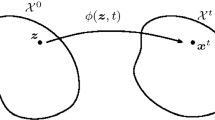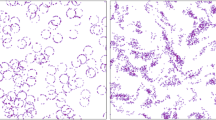Abstract
We propose an innovative algorithm that iteratively evolves a particle system to approximate the sample-wised Optimal Transport plan for given continuous probability densities. Our algorithm is proposed via the gradient flow of certain functional derived from the Entropy Transport Problem constrained on probability space, which can be understood as a relaxed Optimal Transport problem. We realize our computation by designing and evolving the corresponding interacting particle system. We present theoretical analysis as well as numerical verifications to our method.
Access this chapter
Tax calculation will be finalised at checkout
Purchases are for personal use only
Similar content being viewed by others
Notes
- 1.
When \(\mu ,\nu \) are absolute continuous with respect to the Lebesgue measure on \(\mathbb {R}^d\), the optimizer of (1) is guaranteed to be unique.
- 2.
In this paper, we choose the Radial Basis Function (RBF) as the kernel: \(K(x,\xi )=\exp (-\frac{|x-\xi |^2}{2\tau ^2})\).
- 3.
Notice that we always use \(\nabla _x K\) to denote the partial derivative of K with respect to the first components.
- 4.
Here \(\mathcal {N}(\mu ,\sigma ^2)\) denotes the Gaussian distribution with mean value \(\mu \) and variace \(\sigma ^2\).
References
Agueh, M., Carlier, G.: Barycenters in the Wasserstein space. SIAM J. Math. Anal. 43(2), 904–924 (2011)
Ambrosio, L., Gigli, N., Savaré, G.: Gradient Flows: In Metric Spaces and in the Space of Probability Measures. Springer, Heidelberg (2008). https://doi.org/10.1007/978-3-7643-8722-8
Benamou, J.D., Brenier, Y.: A computational fluid mechanics solution to the Monge-Kantorovich mass transfer problem. Numer. Math. 84(3), 375–393 (2000)
Benamou, J.D., Froese, B.D., Oberman, A.M.: Numerical solution of the optimal transportation problem using the Monge-Ampère equation. J. Comput. Phys. 260, 107–126 (2014)
Brenier, Y.: Polar factorization and monotone rearrangement of vector-valued functions. Commun. Pure Appl. Math. 44(4), 375–417 (1991)
Carrillo, J.A., Craig, K., Patacchini, F.S.: A blob method for diffusion. Calc. Var. Partial. Differ. Equ. 58(2), 53 (2019)
Chen, C., Zhang, R., Wang, W., Li, B., Chen, L.: A unified particle-optimization framework for scalable Bayesian sampling. ar**v preprint ar**v:1805.11659 (2018)
Cuturi, M.: Sinkhorn distances: lightspeed computation of optimal transport. In: Advances in Neural Information Processing Systems, pp. 2292–2300 (2013)
Cuturi, M., Doucet, A.: Fast computation of Wasserstein barycenters. In: International Conference on Machine Learning, pp. 685–693. PMLR (2014)
**, S., Li, L., Liu, J.G.: Random batch methods (RBM) for interacting particle systems. J. Comput. Phys. 400, 108877 (2020)
Jordan, R., Kinderlehrer, D., Otto, F.: The variational formulation of the Fokker-Planck equation. SIAM J. Math. Anal. 29(1), 1–17 (1998)
Kantorovich, L.: On translation of mass (in Russian), c r. Doklady. Acad. Sci. USSR 37, 199–201 (1942)
Korotin, A., Egiazarian, V., Asadulaev, A., Safin, A., Burnaev, E.: Wasserstein-2 generative networks. ar**v preprint ar**v:1909.13082 (2019)
Kullback, S., Leibler, R.A.: On information and sufficiency. Ann. Math. Stat. 22(1), 79–86 (1951)
Li, W., Ryu, E.K., Osher, S., Yin, W., Gangbo, W.: A parallel method for earth mover’s distance. J. Sci. Comput. 75(1), 182–197 (2018)
Liero, M., Mielke, A., Savaré, G.: Optimal entropy-transport problems and a new Hellinger-Kantorovich distance between positive measures. Invent. Math. 211(3), 969–1117 (2018)
Liu, S., Sun, H., Zha, H.: Approximating the optimal transport plan via particle-evolving method. ar** via input convex neural networks. In: International Conference on Machine Learning, pp. 6672–6681. PMLR (2020)
Monge, G.: Mémoire sur la théorie des déblais et des remblais. Histoire de l’Académie Royale des Sciences de Paris (1781)
Oberman, A.M., Ruan, Y.: An efficient linear programming method for optimal transportation. ar**v preprint ar**v:1509.03668 (2015)
Otto, F.: The geometry of dissipative evolution equations: the porous medium equation. Comm. Partial Differ. Equ. 26(1–2), 101–174 (2001)
Parzen, E.: On estimation of a probability density function and mode. Ann. Math. Stat. 33(3), 1065–1076 (1962)
Ruthotto, L., Osher, S.J., Li, W., Nurbekyan, L., Fung, S.W.: A machine learning framework for solving high-dimensional mean field game and mean field control problems. Proc. Natl. Acad. Sci. 117(17), 9183–9193 (2020)
Schmitzer, B.: A sparse multiscale algorithm for dense optimal transport. J. Math. Imaging Vis. 56(2), 238–259 (2016)
Seguy, V., Damodaran, B.B., Flamary, R., Courty, N., Rolet, A., Blondel, M.: Large-scale optimal transport and map** estimation. ar**v preprint ar**v:1711.02283 (2017)
Villani, C.: Optimal Transport: Old and New, vol. 338. Springer, Heidelberg (2008). https://doi.org/10.1007/978-3-540-71050-9
Walsh III, J.D., Dieci, L.: General auction method for real-valued optimal transport. ar**v preprint ar**v:1705.06379 (2017)
Author information
Authors and Affiliations
Corresponding authors
Editor information
Editors and Affiliations
Rights and permissions
Copyright information
© 2021 Springer Nature Switzerland AG
About this paper
Cite this paper
Liu, S., Sun, H., Zha, H. (2021). A Particle-Evolving Method for Approximating the Optimal Transport Plan. In: Nielsen, F., Barbaresco, F. (eds) Geometric Science of Information. GSI 2021. Lecture Notes in Computer Science(), vol 12829. Springer, Cham. https://doi.org/10.1007/978-3-030-80209-7_94
Download citation
DOI: https://doi.org/10.1007/978-3-030-80209-7_94
Published:
Publisher Name: Springer, Cham
Print ISBN: 978-3-030-80208-0
Online ISBN: 978-3-030-80209-7
eBook Packages: Computer ScienceComputer Science (R0)




